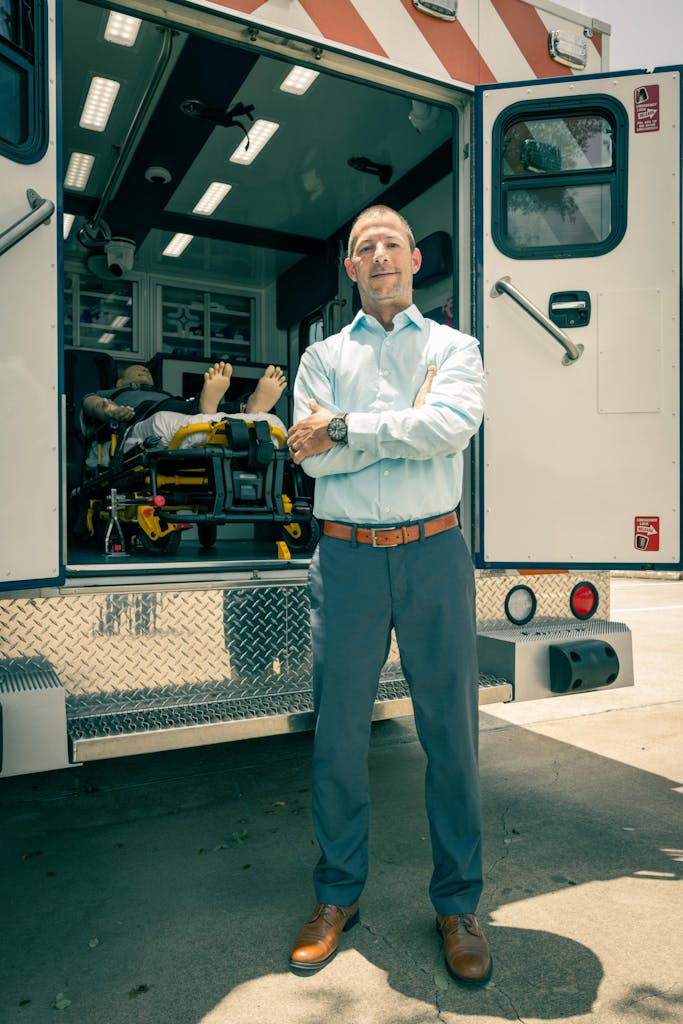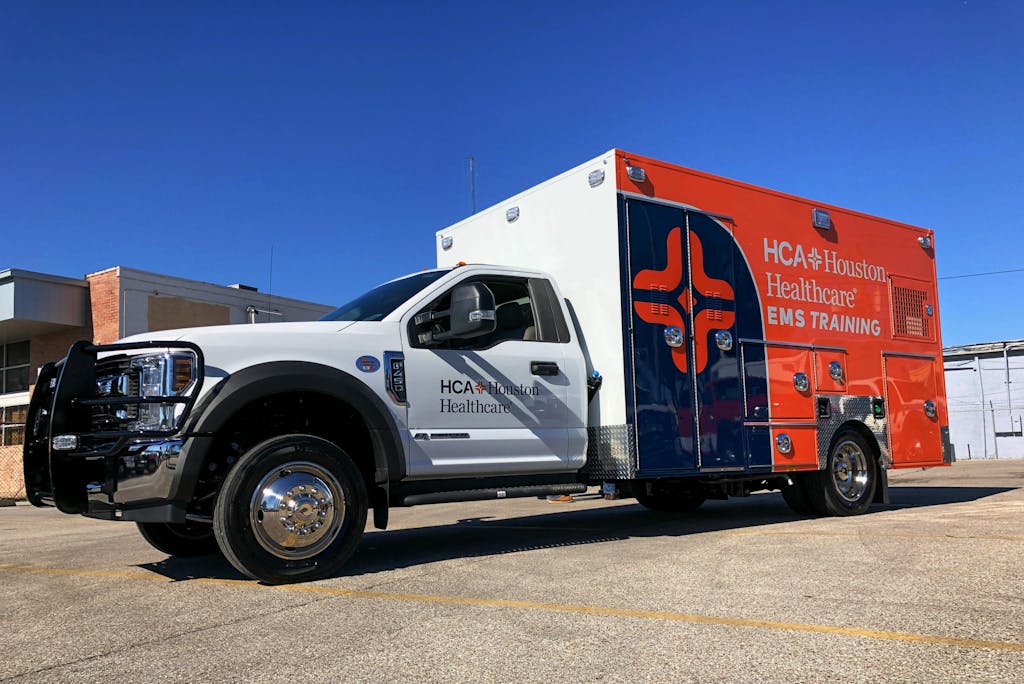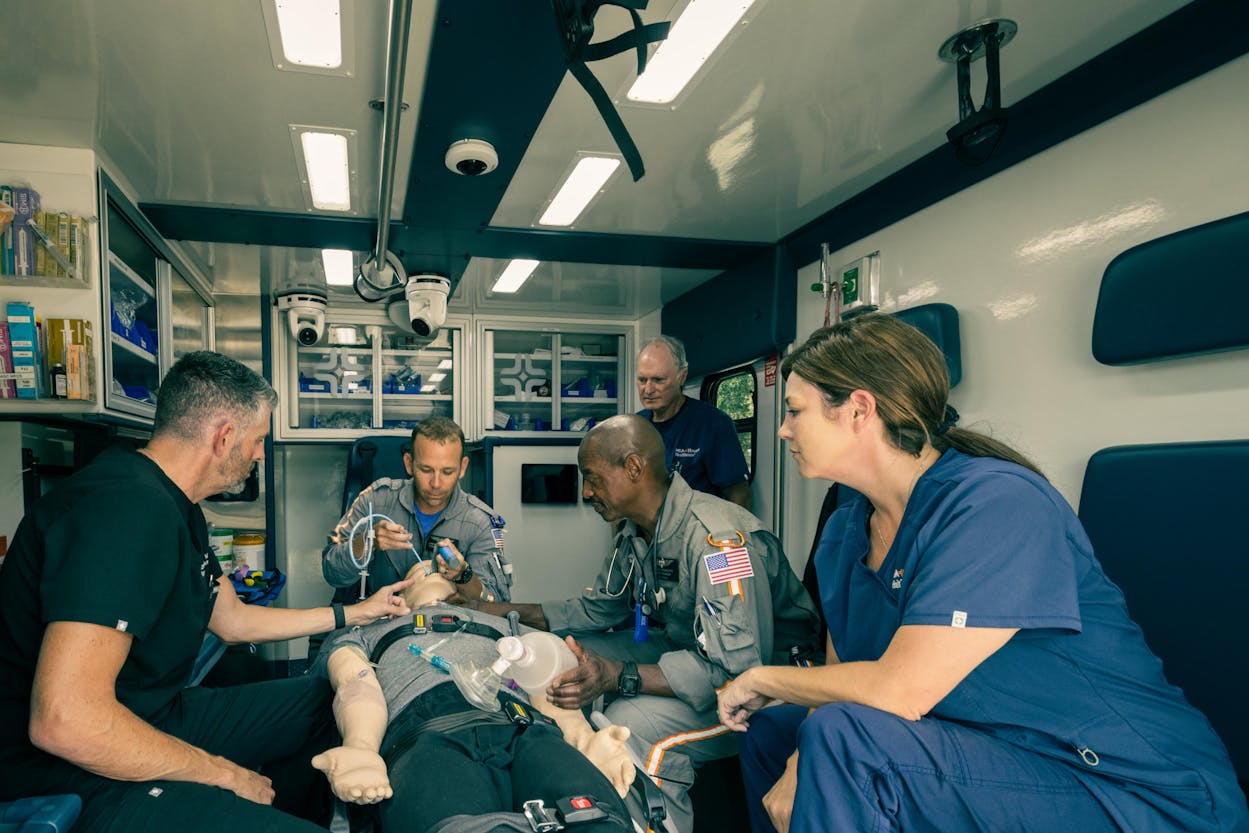Read this story in Spanish here.
Lea esta historia en español aquí.
There are two bodies in the wrecked car: a child and his mother. The woman is pregnant, and by the time the paramedics arrive she has already lost a lot of blood. Nevertheless, the first responders are undaunted; they leap into action, follow their training, and do everything necessary to provide complex, life-saving care in the time they have.
This is not a true story. But it could be.
As part of an ongoing investment in the healthcare ecosystem of southeast Texas, HCA Houston Healthcare has built a comprehensive program for emergency medical services (EMS). The healthcare system’s experienced professionals have traveled 15,000 miles throughout the state, engaged thousands of EMS workers with in-depth trainings, and improved patient outcomes for countless Texas families.
According to Evan Ray, executive vice president and chief administration officer at HCA Houston, this work is an integral component of the organization’s larger commitment to the state and its residents.
“A key part of our strategy is bringing the care to where it’s needed most,” Ray says. “We have among the lowest mortality index in the market, as well as the lowest complication index: I think a lot is tied to EMS.”
The car wreck example is precisely the scenario Ray’s colleagues will simulate as part of their EMS training. In fact, EMS Education Team leader Bill Kallal can run any number of scenarios with help from a first-of-its-kind Mobile Education Lab (MEL, for short) and a literal family of high-fidelity mannequins untethered to any plugs.
“I like to say that the only thing our mannequins can’t do is crawl, walk, or run,” Kallal says. This means they can breathe, bleed, seize, blink, and cry. EMS trainees can take the mannequins’ blood, and while they’re doing it, the mannequin may say “ouch” or tell them it hurts, offering clues that the trainee is doing it wrong or that there are other problems at play. The mannequins are also used to teach first responders how to start IVs, conduct advanced airway maneuvers, and respond to everything from car wrecks to shootings.

If you think this sounds incredible, you’re not alone. When Kallal joined HCA Houston in May 2021, he was “blown away” by everything his new team could do. In his two decades of EMS work, he had never seen anything like it.
“No one else is really doing this,” he says. “There are pockets all throughout southeast Texas that just don’t have those same abilities to do high-performance training, and that’s where we fill in the gaps.”
Kallal’s crew takes a proactive approach to fill in those gaps. A team of outreach personnel conducts direct conversations with first responders in cities like Brenham, Corpus Christi, and League City, determining what exactly they see on the ground and what additional training is necessary.
In the last year alone, trainings have reached more than 3,500 EMS partners throughout southeast Texas, educating first responders on pediatric seizures to breech deliveries and other high-risk situations. The trainings go beyond medicine, too, engaging fire departments and local police departments.
In one recent example, HCA Houston collaborated with a SWAT team, EMS professionals, a trauma surgeon, and other local law enforcement to simulate an active shooter response. With help from the EMS team (and one of the adult mannequins), the SWAT team breached a building, provided safe extraction to the Mobile Education Lab, and successfully completed life-saving care of the “patient.”
“This isn’t just a training event; it’s an educational opportunity, and a lot of the people we engage are starving for this education,” Kallal says. “Pre-hospital (EMS) personnel love what they do. They love to care for people and help their communities, and that’s what we want to help them do.”
“A key part of our strategy is bringing the care to where it’s needed most.”
Evan Ray, Executive Vice President and Chief Administration Officer at HCA Houston Healthcare
As impressed as Kallal was with the technical capabilities of his new team, he was even more impressed with the way his fellow EMS personnel collaborated with hospitals and emergency rooms. His team has developed a proficiency for transition events: the critical moment when fire departments and EMS agencies transfer care into the hands of the ER nursing staff.
“Being completely untethered allows us to prepare people for every scenario,” Kallal notes, including care providers who must take flight.
In early 2020, HCA Houston announced its AIRLife ambulance service. With help from three helicopters and a team of flight nurses, paramedics, and pilots, the organization can now reach Texans up to 120 miles away from HCA Houston sites like The Woman’s Hospital of Texas in Houston.
“When you get into rural communities, access to high-quality healthcare becomes more and more difficult,” says Allen Sims, EMS executive for the HCA Healthcare Gulf Coast Division. “The AIRLife connection provides a seamless connection to rural communities, and we’re trying to fill as many unmet needs as we can.”

Like Kallal, Sims is focused on using the organization’s resources to improve patient outcomes. Through trainings, Sims explains, HCA Houston invests in talented medical professionals throughout Texas and, in turn, improves patient outcomes far beyond Houston.
As the organization’s investment in their broader community has grown, so has the range of specialties. For instance, Sims cites the trauma specialists who have brought their expertise to rural communities.
“We’re focused on building depth of knowledge,” he says. “We want to empower our partners to care for their people with the latest techniques and expertise.”
Evan Ray says he has “endless” stories about the power of that expertise, but one, in particular, stands out.
In April 2022, a frequent jogger in his 20s suffered a stroke while on a run. EMS personnel responded to the scene, providing the critical care the jogger needed on route to the hospital. Once the transition to the ER was complete, doctors took care of the blood clot in his brain, saving his life.
“To me, that story shows the vital role EMS plays in these communities,” Ray says. “Because of their training and knowledge, lives are being saved every day.”






